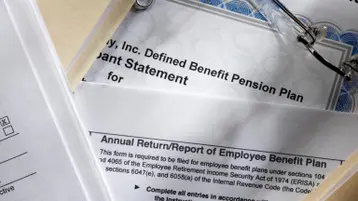Best Questions to Put in Your Employee Benefits Satisfaction Survey

Table of contents
- 1.The importance of employee benefits satisfaction surveys
- 2.21 questions to consider asking in your employee benefits satisfaction survey
- 3.Additional questions:
- 4.Further questions:
- 5.Best practices for your employee benefits satisfaction survey
- 6.Additional best practices:
- 7.Examine industry employee benefits surveys
- 8.Observe last year’s trends and benefits priorities, as well
Recently, Glassdoor reported, “Hiring is going to be difficult in 2022.” Specifically, the labor shortages that caused hiring and retention challenges will likely continue. This means employees will have more bargaining power, including when it comes to negotiating better benefits. Bottom line: if your employees aren’t happy with their benefits, it increases the chances of them accepting a stronger offer from your competitor. You can prevent this by conducting employee benefits satisfaction surveys and making feasible adjustments based on the results.
The importance of employee benefits satisfaction surveys
Employees often have unique preferences and needs regarding benefits. For example, some may prioritize flexibility and parental leave over career development opportunities. Others may value retirement plans more than health insurance, particularly if they are eligible for health coverage under their spouse’s plan. Even if they value the same categories of benefits, the order of importance may differ. Moreover, some employees may be fully or mostly pleased with their benefits, others may be thoroughly dissatisfied, and some may be somewhat satisfied. There’s also more to employee benefits than the benefits themselves. For instance, how you communicate benefits to your employees can impact their satisfaction level. All of these variables can be addressed in an employee benefits satisfaction survey. The survey can provide substantial insight into:
- Each employee’s benefits preferences and needs
- How each employee rates the quality of benefits received
- Additional benefits you should offer or consider
- How your benefits stack up against your competitors’
- The effectiveness of your benefits administration and communication processes
- The performance of your benefits vendors
- Areas of improvement
The survey comes in the form of a questionnaire, and is usually done on an annual basis.
21 questions to consider asking in your employee benefits satisfaction survey
The specific questions you should ask depend on your unique business situation, including the benefits you offer and those you’re considering. That said, below are 21 questions to consider putting in your employee benefits satisfaction survey.
- Which 3 benefits do you need the most? You can include benefits offered and not offered by the organization.
- Which 3 benefits are the least important to you? You can include benefits offered and not offered by the organization.
- Do you clearly understand the benefits you receive from us? If not, please tell us what you need a better understanding of.
- How satisfied are you with your health insurance plan? What would you like to see changed, if anything?
- Do you believe your health insurance costs are too high? This includes the cost-sharing amounts deducted from your paychecks, plus your deductibles, coinsurance, and copayments.
- Does your benefits package meet your (and/or your family’s) needs? If not, please tell us what’s missing.
Additional questions:
- How satisfied are you with your retirement plan? Please tell us any changes you’d like to occur. For instance, would you like to make after-tax 401(k) contributions instead of pretax contributions? Do you feel our company match is too low? Do you believe the process for getting a 401(k) loan is too difficult?
- How well were our benefits packages explained to you when you first joined the company? For instance, did you gain a proper understanding at that time, did you have to seek clarification, or were you confused but did not seek assistance?
- How satisfied are you with your current paid time off? This includes the amount of PTO you’re allowed per year, along with your thoughts on PTO usage and payouts.
- How important is working remotely to you? You can mention any interest you have in hybrid work (i.e., working partially onsite and partially remote).
Further questions:
- Which perks do you believe can help to promote a positive work culture? For example, free office snacks, employee recognition, collaboration tools, etc.
- How can the organization help you achieve more work-life balance?
- How satisfied are you with our career development and training programs? Please include any suggestions for improvements.
- How would you rate the quality of service received from our benefits vendors? This includes benefits advisors and service providers you interact with.
- How satisfied are you with our benefits enrollment procedures and tools? Please tell us any shortcomings you’d like to see rectified, including in our benefits technology.
- How was your last open enrollment experience? What went right, and what went wrong?
- What changes would you like to see in the next open enrollment season?
- Do you find our benefits competitive compared to those offered by other organizations? If not, what would make our offerings more competitive?
- How likely are you to recommend us to your family or friends, based on our benefits packages? You can use a scale of 1-10.
- Do you know whom to contact if you have questions or concerns about your benefits?
- Do you have other comments or concerns about your benefits package or our benefits programs and policies?
Best practices for your employee benefits satisfaction survey
- Determine the most optimal way to develop the survey and to collect responses. Modern HR software offers an automated platform that lets you easily create and distribute custom surveys and collect responses.
- Make the survey fully anonymous, or give employees the option to remain anonymous. Some experts recommend the former, others the latter. Based on the confidential nature of many of the questions we provided, you may want to make the survey fully anonymous.
- Include as many open-ended questions as possible. This is the best way to get useful, quality responses. Offering only multiple choice answers or rating scales will limit your ability to truly comprehend how your employees feel about their benefits.
- Avoid asking too many questions. These days, people generally have short attention spans, especially when reading. Your employees are likely to get bored or overwhelmed by too many questions, and this may impact the quality of their responses.
- Avoid asking too few questions. On the flip side, not asking enough questions will lead to a shallow understanding of your employees’ views on their benefits.
Additional best practices:
- Make sure employees have enough writing space for each question. But do not provide too much space, as this could make the survey seem longer than it actually is.
- Be transparent about the survey, including why you’re doing it, how employees can access it, and the process for evaluating survey responses.
- Get buy-in from stakeholders before you develop and run the survey. Consult with the necessary people in HR, finance, payroll, and legal, plus managers, benefits consultants, and benefits providers.
- Reinforce the importance of the survey to your employees. This is very important, because if employees do not know the value of the survey, they likely won’t complete it appropriately (or at all).
It’s also a good idea to assess the benefits landscape and what your competitors are doing. This can help inform the questions you ask in the benefits satisfaction survey.
Examine industry employee benefits surveys
In SHRM’s recent Employee Benefits Survey, employers ranked the importance of their benefits categories as follows:
- Health-related benefits (88%)
- Retirement savings and planning benefits (82%)
- Leave benefits (82%)
- Family care benefits (70%)
- Flexible work benefits (70%)
- Professional and career development benefits (65%)
- Financial (non-retirement) benefits ((52%)
- Wellness benefits (46%)
- Education benefits (42%)
- Technology benefits (37%)
- Transportation benefits (12%)
- Housing and relocation benefits (9%)
These statistics can help ensure your survey questions reflect current trends. For instance, if you do not offer wellness or education benefits, you can ask your employees how important those 2 benefits are to them.
Observe last year’s trends and benefits priorities, as well
The benefits landscape tends to shift from year to year, and these changes impact how employers approach benefits internally. For example, the SHRM survey reveals that employers’ benefits priorities are shifting now that the COVID-19 pandemic is receding. At the beginning of the pandemic, employers felt retirement plans were not as important as health, leave, and flexible work benefits.
Now that the pandemic is retreating, employers rank retirement plans as the 2nd most important benefit, just behind health benefits. So, when preparing your survey questions, make sure you evaluate last year’s and the current year’s benefits trends. Keep in mind, too, that you can conduct the surveys more frequently than once per year. For instance, you can do them twice per year, or whenever you need employee answers to inform your benefits process.
This article is for informational purposes only, is not legal, tax or accounting advice, and is not an offer to sell, buy or procure insurance. It may contain links to third-party sites or information for reference only. Inclusion does not imply TriNet’s endorsement of or responsibility for third-party content.

Grace Ferguson
Table of contents
- 1.The importance of employee benefits satisfaction surveys
- 2.21 questions to consider asking in your employee benefits satisfaction survey
- 3.Additional questions:
- 4.Further questions:
- 5.Best practices for your employee benefits satisfaction survey
- 6.Additional best practices:
- 7.Examine industry employee benefits surveys
- 8.Observe last year’s trends and benefits priorities, as well






